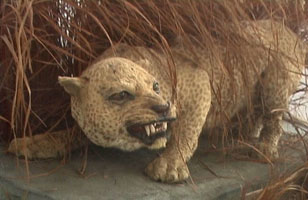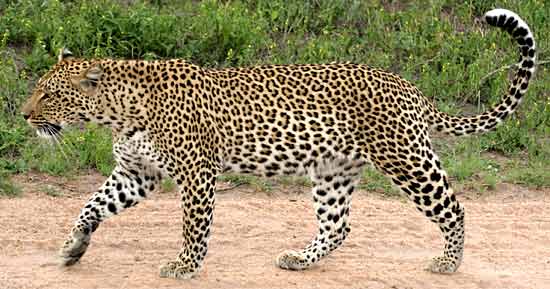There’s news articles on leopards. if you wanna know more about leopards, see the articles:
LEOPARD GOES FOR THE KILL IN MULUND LOBBY
A 20-second CCTV camera clip, which has gone viral, has scared the daylights out of nearly 1,000 residents of a Mulund housing society, which shares a boundary wall with Sanjay Gandhi National Park.
The clip, recorded at 2.38 am last Friday, shows a full grown leopard walking into the lobby of one of the wings (B-7) of Lok Nisarg Apartments in Mulund (W). India batsman Ajinkya Rahane resides in Wing B-2 of the society.
The leopard is then seen approaching a ground floor apartment, where a dog was sleeping outside. It is seen grabbing the hapless dog by its neck, and dragging it out even as the dog wriggled for a few seconds.
Suresh Pindarkar, the watchman on duty at B-7 when the leopard nonchalantly ventured into the society, saw the kill from behind an iron grill door abutting the stairway.
The society chairman, G P Lagad, said a shaken Pindarkar told him that he noticed the leopard only when the dog yelped in fear. “Pindarkar told me it was all over within seconds,” he said.
The society, which has seven wings, put up iron grill doors near the stairway of each building after a few leopard visits, and is now planning to install similar doors at the lobby level.
Lagad said Friday’s victim, Raju, was the sixth dog killed by the leopards at their premises in the few years. “The clip is spinechilling. It seemed a ghost entered the building and took the dog away. The residents of Flat 003, at whose doorstep the dog was sleeping, are especially concerned, and so are the others living on the ground floor,” he said.
Animal activist Pawan Sharma, co-ordinator, Resquink Association for Wildlife Welfare (RAWW), said leopard visits to the society were hardly surprising as there is just a wall separating it from the national park.
“If the residents want, we can organise a session wherein we can suggest ways to tackle such situations. If the residents take precautions, they won’t be harmed,” he said.
The Lok Nisarg residents, however, blamed the Forest department for not repairing the boundary wall. Tukaram Kolambkar, who resides on the sixth floor of B-7 building, said he was extremely worried for his son, who returns home late in the night.
The residents have now been instructed to not let the children and the elderly venture out alone, as the society reports frequent leopard visits between June and September. Ground floor resident Manisha Gada said till the time iron grill doors were put up at the lobby, the residents will remain on tenterhooks.
“Those who frequently find wild animals at their doorstep will understand our plight. We are scared for our children when they are playing on the compound, we are worried about family members when they return late from work,” she said.
Sunil Limaye, field director, Sanjay Gandhi National Park, said he had seen the clip. “Our leopard rescue team will soon visit the spot. The residents need not worry,” he said.
LEOPARD TRAPPED IN WELL GETS LUCKY
lured into cage with chicken in it
Updated: Tuesday, 25 Jun 2013, 8:48 AM EDT
Published : Tuesday, 25 Jun 2013, 8:48 AM EDT
OOTY, India (NBC/RTV) – A leopard that fell down a well in southern India throughout the weekend got a lucky break.
The leopard became trapped at the bottom of the dry well in India’s Tamil Nadu state, and locals reported the situation to forestry officials.
After seven hours and the use of some ingenuity, they managed to bring the big cat up.
They lowered a cage into the well. Inside was an unfortunate chicken who had been chosen as bait.
The trick worked, and they were able to haul the cage and the cat up from the bottom of the well.
It was later released back into the wild.
Here is a video of the leopard in the well:
Leopard trapped in well gets lucky.
ENDANGERED SNOW LEOPARDS GET A HELPING HAND FROM A UNLIKELY PLACE
he endangered snow leopard has a new and unusual ally in its fight to survive on planet Earth — Tibetan-Buddhist monks.
Tucked away in the remote and perilously high mountain reaches of the Sanjiangyuan region of China, four Tibetan monasteries have agreed to work cooperatively with conservationists from the nonprofit Panthera, local NGO Shan Shui and the Snow Leopard Trust to help save the snow leopard.
Only 3,500 to 7,000 snow leopards are left in the wild. They are listed as “endangered” by the IUCN List of Threatened Species. Unlike other big cats, snow leopards cannot roar. For this reason, in addition to their reclusive nature, they are known as “mountain ghosts.”
Snow leopards live primarily in steep, ruggedly mountainous areas of Central Asia at altitudes between 9,800 and 17,000 feet. In these remote and lonely places, craggy cliffs and dangerous ravines help them hunt the wild goats and sheep they depend on to survive. Snow leopards can be found in only twelve countries, including India, Bhutan, Kazakhstan, Kyrgyzstan, Mongolia, Nepal, Pakistan, Russia, Tajikistan and Uzbekistan. China, however, represents about 60 percent of their remaining range.
Fortunately, the same qualities that make such far-flung and dangerous terrain attractive to snow leopards also appeal to Buddhist monks. Realizing this, in 2009, Panthera initiated cooperative programs with four monasteries in China, partnering with them to better protect the snow leopard.
The monks undergo a training program and then systematically patrol the area surrounding their monasteries. They use cameras, binoculars and GPS systems provided by Panthera to observe, monitor and record the wildlife they see, including the snow leopard.
Monks also work as field assistants, doing everything from changing camera batteries to collecting feces samples. According to Dr. Li Juan of Peking University and the Snow Leopard Trust, the monks are especially interested in the photographs Panthera collects using camera traps. They love to get copies, which they eagerly share with their communities.
Perhaps most importantly, however, the monks demonstrate their value to this program when a snow leopard preys on a local herdsman’s livestock.
“When a snow leopard kills a sheep, goat, yak or even a young camel, it is a huge economic loss to the herder. It is hard to blame them for wanting to kill the snow leopard in retaliation,” Dr. Tom McCarthy, head of Panthera’s Snow Leopard Program, told Mongabay.com.
The Buddhist monks are sometimes the only voice the angry locals will heed, so their active involvement in defusing these situations can be critically important. Monks have even been known to pay a herdsman for his loss from their own meager pockets just to keep the leopards safe.
In addition to retaliatory killings, the other primary threats to the snow leopard’s survival are loss of its natural prey, such as ibex and blue sheep, due to overhunting and poaching of the leopard for its pelt and bones.
The partnership with the four monasteries has been surprisingly effective, according to Dr. Li Juan. “As a strategy, monastery-based snow leopard conservation could be extended to other Tibetan Buddhist regions, covering about 80 percent of global snow leopard range,” she said.
Most surprising of all, it appears to Dr. Li Juan that “more snow leopard habitats in the Sanjiangyuan area could be directly protected by monasteries than the core areas of the Sanjiangyuan National Nature Reserve.”
In the battle to protect endangered leopards, sometimes the best warrior is a Buddhist monk.
—————————————————————————————————————————————————
My opinion to these articles are that I’m glad that a lot of people are able to help leopards. Rescue teams, and scientists (doctors). If you want to see more articles, go to this link:
http://bigcatrescue.org/leopard-news/
thanks!


